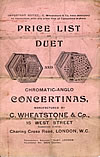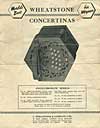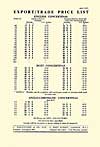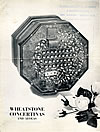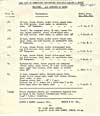Wheatstone Anglo Concertina Pricelists
collected by Chris Algar
These Wheatstone & Co. price lists have been collected
by Chris Algar of Barleycorn Concertinas
over the last twenty-five years. They have mostly been found in concertina cases with
few hints to date them.
The approximate dates ascribed to the price lists here are based on internal evidence,
as follows:
- Address: Wheatstone moved from Conduit Street to West Street in 1905, where
they remained until after the war. Parts of the operation were moved to other
locations around 1946 and 1951, but the West Street flagship remained until around 1956.
- Postcode: The basic postcode areas (e.g., "W.C.") from the late nineteenth century
were augmented with numbers (e.g., "W.C.2") added in 1917.
- Telegraph Address: some are "Clef", some (later) "Clef, WestCent".
- Telephone Office: the prefix "Central" is used until it is overstamped with "Gerrard",
which is used until it is in turn overstamped with "Temple Bar".
- Awards: most lists carry dated award medals, but the latest is 1908.
- Dates and Events Mentioned: rubber stamps and printed notes mention the British Empire
Exhibition of 1924, and the Concertina Centenary in 1929 (on one list the date of the centenary
contains a typographic error, corrected by hand).
An overstamp marks the incorporation of Lachenal & Co., probably 1934–1935.
- Printers' Dates: tiny lines supplied by the printer sometimes record the size of the press
run and the date of printing.
- Trademark Registration: Numbered trademarks for "Æola" (440676) and "Wheatstone" (440677) were
assigned to Wheatstone & Co. by successive registrations in September 1923, and so the numbers
cannot have been known earlier.
- Pitch: some lists offer tuning in C=540 described as "Old Philharmonic Pitch" or
"English Concertina Pitch", some offer tuning in C=522 described as "New Philharmonic Pitch"
or "Modern Low-Pitch New Philharmonic", some offer a choice. (Both pitches were well-established
by this period, but Wheatstone changed from 540 to 522. The current C=523.3 [A=440] pitch is
mostly post-World War II, stemming from an international agreement in 1939.)
- "Æola" and "octagonal": only some lists offer these models. (The earliest known Duet
Æolas appear to have been produced in December 1910; English Æolas--not necessarily
octagonal--appear in the Production Ledgers from September 1889.)
- Tutors Listed: some lists offer no tutors (presumably not yet published), others offer them
at various prices reflecting successive revisions. The first English tutor was offered
by Wheatstone at 5 shillings, rising to 6 shilings. The first duet tutor was published
by Wheatstone in 1914; revisions were first 2/6 and then 4/6.
- Model Numbers: we can check the model numbers offered against the production records in the
Wheatstone Concertina Ledgers
at the Horniman Museum, London. For example, model 32 as a 46-key instrument with non-steel
reeds is last seen in the Production Ledgers about 1920; a different model 32, with 39 keys and
steel reeds, is first made about 1934. The price lists reflect such changes. The traditional
model numbers are replaced with a new nomenclature using one digit for size and one letter
for system ("1E", "2D", "3A", and so forth) about 1947, following the war.
- Prices: surprisingly, the variations in prices do not seem to be of much help in dating.
Robert Gaskins, Chris Algar, Randall Merris, and Wes Williams joined in the project to assign
dates to the price lists. Additional documents were contributed by Mike Eichner and Jim Lucas.
Do you know another resource that we should include?
Tell us about it.
Reprinted from the Concertina Library
http://www.concertina.com
© Copyright 2000– by Robert Gaskins
|
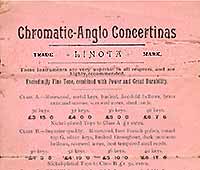
Page for Wheatstone & Co.
"Linota" chromatic-Anglo —
"exceedingly fine tone
combined with power … ."
Links to related documents
-
 Wheatstone English Concertina Pricelists
Wheatstone English Concertina Pricelists
- collected by Chris Algar
-
Most of these pricelists were found in old concertina cases. From internal evidence it is
possible to date the lists c. 1915 to c. 1965 (plus one very early pricelist dated 1848,
from the collection of the Horniman Museum, and a list published as an advertisement
in a trade directory in 1859). These lists contain information about Wheatstone
model numbers and descriptions which are useful to interpret the Wheatstone Concertina Ledgers.
See also Duet pricelists from Wheatstone.
See also Anglo pricelists from Wheatstone.
- Posted 15 May 2003
- » go to directory
-
 Wheatstone Duet Concertina Pricelists
Wheatstone Duet Concertina Pricelists
- collected by Chris Algar
-
Most of these pricelists were found in old concertina cases. From internal evidence it is
possible to date the lists c. 1910 to c. 1965 (plus one very early pricelist for Double duets c. 1850).
These lists contain information about Wheatstone
model numbers and descriptions which are useful to interpret the Wheatstone Concertina Ledgers.
See also English pricelists from Wheatstone.
See also Anglo pricelists from Wheatstone.
- Posted 15 February 2003
- » go to directory
-
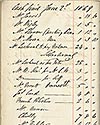 Wheatstone Concertina Ledgers
Wheatstone Concertina Ledgers
-
Directory
-
Historical business records of C. Wheatstone & Co. from
the Horniman Museum in London. Earlier ledgers from the Wayne Archives
contain company sales records from the late 1830s to the 1860s
along with production records from the 1860s to the 1890s and some
early records of wages and other payments. Later ledgers from the Dickinson Archives
contain production records from 1910 to 1974. All surviving ledgers
have been digitized (some 2,300 pages in total) and made available free on the web for
private research.
The same material is also available to buy on an inexpensive CD.
Includes an introduction to the project by Margaret Birley, Keeper of Musical Instruments at
the Horniman Museum, and an article by Robert Gaskins describing in detail how the ledgers
were digitized.
-
Posted 15 June 2003; Updated 15 June 2005
-
» go to directory
-
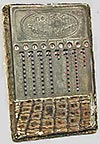 Calculate Modern Values of Historic Concertina Prices
Calculate Modern Values of Historic Concertina Prices
-
by Randall C. Merris and Robert Gaskins
-
“How much would that be in new money?”
An interactive calculator to convert sterling values from any
year 1830–1999 to the equivalent value in the year 2000.
The calculation preserves the relation between the chosen value and
“average earnings” for the two dates; this method makes it
appropriate for converting wages and capital sums, and also for
expensive discretionary products such as concertinas. The calculator deals
with both “old money” (prior to 1971) and the later decimalized
currency. It is especially useful for understanding historical documents such
as old advertisements and pricelists, and the sales prices and wages
recorded in the
Wheatstone Concertina Ledgers
from the Horniman Museum.
-
Posted 01 January 2005
-
» read full article
|


